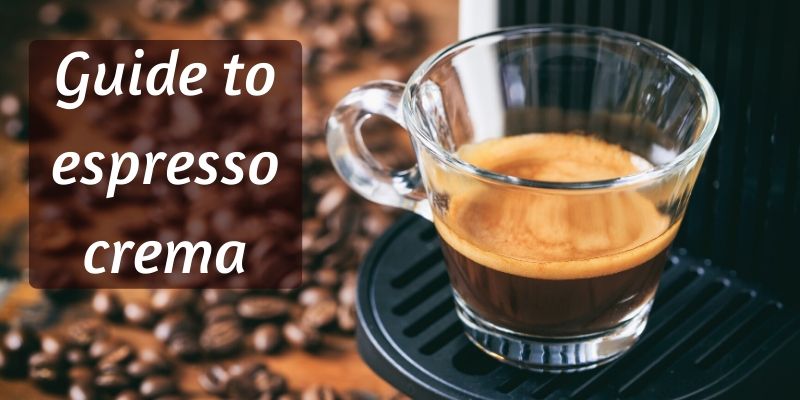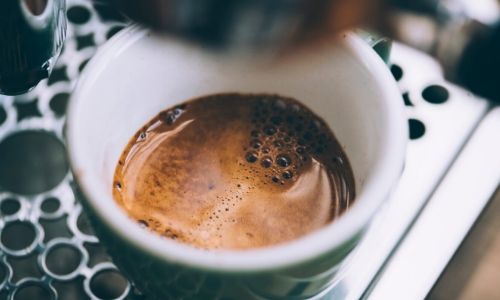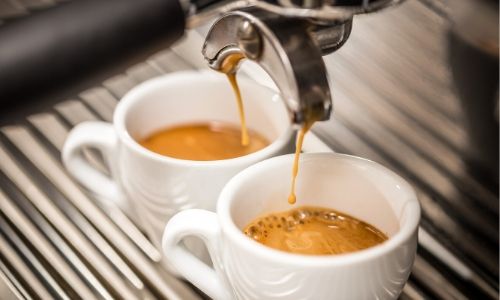When pulling an espresso shot, you're going to end up with a layer of crema on top of your coffee.
But just what is crema on espresso ?
Does it matter ?
Does it make or break an espresso ?
And how do you know you got the crema right or not ?
Worry no more, this guide's meant to walk you through everything crema-related, so you can really understand what's happening in your espresso.

Table of Contents
So what is crema on an espresso ?
Crema is the thick layer of golden brown foam that normally forms on the top of an espresso shot.
It's made by a combination of the pressure and heat of the water, going through the tightly packed coffee grounds and extracting the coffee oils.
Espresso is pretty much the only drink that will produce a steady and sustainable crema.
The only other brewing method that might produce something similar to crema (albeit a thin version) is the Moka pot.
If you've never really seen a shot of espresso on its own, then you may heve seem the amber/light brown streaks and swirls on lattes and cappucinos. That is the crema, after it's been mixed with foamed milk.
How is crema made when you pull an espresso shot ?
I'll do my best to explain the process, though you must remember that it's really not as complicated as it sounds.
So, when you pull an espresso shot you simply pull hot water, with a lit of speed, through a puck of tightly packed ground coffee. All of that contributes to making the crema.
The heat of the water you use, as well as the pressure with which it passes through the ground coffee is a big factor in producing quality crema.
It's the heat and pressure that strips the coffee oils from the ground coffee, and aerates it, much like frothing milk with a wand.
This is only possible when the coffee is still fresh.
Meaning it's been roasted and ground recently (like a couple days ago), which means it still retains its flavoring and hasn't released ll of its CO2.
It's the CO2 that is released when ground coffee comes in contact with the hot water that helps produce crema.
With other brewing methods, you might've noticed the ground coffee bubbling up and forming a thin crema. That's called blooming, and it's a much tamer version of crema.
And finally, when you add coffee to the portafilter you'll also need to tamp it, press it down into a compact puck.
If it's not compact, there will not be enough resistance and the crema won't form and the entire espresso shot will be weak.
So in short, the coffee oils are stripped from the ground coffee when the hot water comes in contact with the ground coffee. It's pushed through them so fast and hard it creates a sort of foam, that's also naturally derived from coffee's blooming process.
I hope I was clear enough on this. The process has so many factors contributing to the final look and feel of the crema. It's kind of difficult to pin down each one and explain it, without going into how the other factors matter.
Does crema make or break an espresso ?
This one is completely, completely up to you.
Really, each espresso wizard has their own opinion and no two baristas will ever agree on what the perfect crema is.
Or whether crema really matters in an espresso.
Often you can take a nice layer of crema, with the proper color variation - usually golden brown with darker specs - as a sign of a damn good espresso.
Though what 'damn good' means is up to anyone. It's certainly not got to do with flavor, at least not at much as it has to do with other aspects.
Aspects such as bean freshness, how well the shot was pulled, over or under extraction of the coffee, how hot the machine was (too much or too little), and so on.
In my opinion, and this is a very personal thing, crema is simply there to make pretty patterns with.
I don't like the taste of it, I've had it with and without milk and I like it better with milk.
However, an espresso with no crema would make me think something went terribly wrong. Either the coffee is stale, or overextracted, or the machine was too hot and now it tastes burnt, or something else.
Crema can and does fizz out in a few minutes, so don't worry if you made an espresso now and had to run off for 10 minutes because the cat tipped over the Christmas tree.
The crema will still be there, kind of. In a faded, darker patch and most of the bubbles will now be dry and semi-transparent.
The downside is that once the crema dissipates, so does the flavor in espresso.
It's not the crema's fault, but the fact that any coffee starts to lose flavor the moment it's done brewing. And it also loses any crema it has. They simply happen at the same time, the flavor isn't in the crema.
You can't get latte art without crema
As mentioned before, crema is one of the two elements you need to make latte art.
If you're an aspiring barista and really need to practice your patterns, then you need good, thick crema to work with. Not necessarily an inch (2,5 cm) thick crema, but rather a very creamy layer that's made up entirely of the tiniest bubbles ever.
Anything past 1 cm/0.3 inch is a little much.
If you're not very much into latte art, and you don't really like the taste of crema, then you might no care for it at all.
In fact, you might even skim it off the top of your espresso.
Some folks do that. I wouldn't, because I think it takes away from the overall look of the drink, but I can totally see how it would help the taste.

How much crema is ideal ?
We touched on this a little before, but it's actually a bigger topic. Why ?
Well, because crema is actually an indicator of what beans you're suing, how fresh they are, how good the espresso machine is, and how good the barista's skills are.
So, what's too much crema ? Or too little.
On an average cup of espresso - that's 1 oz/33 ml - the cap of crema should be somewhere between 0.5 - 1 cm thick. That's about 0.2 to 0.4 inch.
The thicker the crema, the fresher the coffee and the better the machine and the barista. But, too thick a crema can be a sign of using too much Robusta in the coffee bean blend.
If this a problem ?
Well, yes and no. Yes, because Robusta tastes much more bitter than Arabica.
But also no, because it has more caffeine and helps produce more crema than Arabica beans.
Too much Robusta can produce too much crema, and it might end up as a very disappointing espresso shot.
Although if you're going to use the espresso for a very large and milky drink - like a latte or a big cappuccino or latte macchiato - then maybe it's not so bad.
The espresso really needs to stand up to all the milk and sugar thrown at it, and Robusta manages to cut through all that.
Right, back to how much crema is ideal: 0.5 - 1 cm thick. That's about 0.2 to 0.4 inch.
What can influence crema
So now you know what crema is, if it matters or not, and how much is too much.
Now lets talk about what can change the quality and appearance of the crema. You can also use this as an indicator to figure out whether your espresso shot went well or not.
Do keep in mind that crema does oxidize a little, and it may darken around the edges if you just let it sit for a few minutes.
1. The coffee's freshness
This might be one of the most important factors when it comes to how good and thick the crema ends up.
Freshly roasted and ground coffee beans make for a thick and glossy crema. It'll have the entire host of microbubbles to make it thick, and it will be a nice golden brown color.
If the coffee were stale, or just not very fresh, the crema would be thinner, and the bubbles would be larger. This is the kind of crema that dissipates very quickly.
And the reason behind this is because stale coffee has already released much of the CO2 it would when blooming. And a lack of this gas in the ground coffee will make it 'flat', much less capable of bubbling up and contributing to the structure of the crema.
2. The roast level of the coffee
Another important item, a dark (or simply darker) roast will produce the color in the crema we're looking for.
Too light a roast - like a simple medium or anything lighter - will result in a light brown crema, and maybe even lighter towards beige or off-white.
Does this matter ? A little, in regards to the taste of the overall espresso shot.
But other than that light colored crema isn't necessarily bad.
Although it would probably lead to points take off if in a barista competition.
As for what color is sought after, it's a golden-brown base with slightly darker flecks throughout, especially towards the edges where the initial part of the crema is (photo below).

Why are those flecks important ? I've heard several stories, ranging from irregularities in the espresso beans that lead to a better flavor, to barista skill, to espresso bean origin.
I'm really not sure which it is, but rest assured that if your crema isn't flecked like that, it's still alright.
I'll list here a few examples of an acceptable espresso crema, with and without flecks.

3. How hot your espresso machine is
Espresso machine temperature is really something to take into account.
I don't know about you, but at my workplace folks always get angry when the machine is warming up and they have to wait like, 5 minutes before they can brew.
If they were to brew espresso with water that's below 200 F/93 C they'd get a shot of espresso that's really not very good.
It'd be espresso that's under extracted, and you'd notice there is very little crema, and/or it's on the lighter side.
Most espresso machines, I mean the big professional ones, take a few minutes to properly warm up.
And how they warm up matters, very much.
In short, the espresso machine has a boiler inside, made of brass. I'm talking about the big espresso machines, with a portafilter and not something small like a Nespresso.
That boiler needs to heat up completely (which takes just a few minutes), but that heat needs to transfer to the grouphead and portafiler as well.
I've seen folks leave their machines on for anywhere between 30 to 60 minutes to fully heat up. Not every machine needs to be left this long, it really depends on how large your is and how many metal components there are.
If you've got a massive machine, then you might just need to wait longer. for just one espresso shot, that's a bit much. But if you're brewing for the whole family it might be worth it.
Otherwise, some folks kind of 'cheat' the heating period, and after the first 10-15 minutes brew and 'empty' or 'dry' shot.
Meaning they let hot water come through the machine, through the grouphead and portafilter, effectively heating them up. This is not consistent heat, but it works for one espresso.
If you machine isn't hot enough, it'll give you under extracted coffee and it'll taste kind of flat.
But there's also a way to overheat the machine and thus over extract the coffee.
Play around with the temperature and see which works best for your preferences.
4. The pressure (bars) in your espresso machine
The bars on your espresso machine are what most companies are going to try and push. Does it have 9 bars ? 12 ? 15 ?
The truth is, nothing past 9 bars is really worth believing. I'll get to that in a minute.
The 9 bars refer to the atmospheric pressure, and the amount of it needed to push the hot water through the ground coffee in order to make that espresso.
Nine bars are enough for most areas (9 bars above sea level), unless you live in at a really high altitude and need the extra push.
So the point is, an espresso machine capable of pushing 9 bars will get you a good shot of espresso and a good looking crema.
Too little pressure and the crema will barely come out, only dripping a little. It might also look too dark in that case.
As mentioned before, there isn't really any need for a 15 bar machine. Most machines that advertise they can get to 15 bars can't actually output as much, or not consistently.
There are very few cases where you'd need the extra push, like if you're pulling shots in the Himalayas. Generally folks who live or trek at high altitudes have no business making espresso, of all things.
To get the perfect crema, you ...
So to get the perfect crema, you need to make sure you:
- have a hot enough machine
- your machine can and does output 9 bars of pressure
- have freshly roasted and ground espresso beans
- have a dark roast coffee, as opposed to medium or light
Other than that, there's not very much you can do to make sure your espresso's crema ends up great. It will never taste great, but it can achieve the perfect texture and appearance.
Of course, maintaining a clean and de-scaled espresso machine is going to contribute to a good layer of crema.
Conclusion
Getting the crema just right may or may not be the most important part of an espresso.
Many folks worry about it, but crema isn't the be-all-end-all of an espresso. Unless you get no crema (or very little), or your espresso comes out smelling weird, pretty much any crema is good.
Some coffee types can only do so much for crema, and you should keep that in mind as well.
If you want to know more about coffee or tea, feel free to check the related articles below. Who knows what else you might find ?





